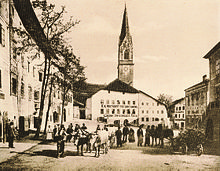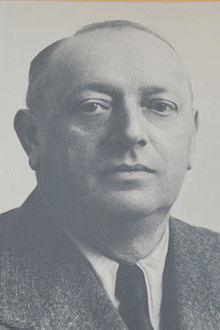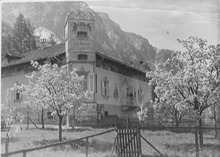Josef Hofstätter winery
The Josef Hofstätter winery in Tramin is one of the most traditional wine producers in the South Tyrolean wine-growing region . The winery is run by the Foradori Hofstätter family.
history
The Pinot Noir vine ( Pinot Noir , Pinot Nero ) took the chemist and university professor Ludwig Barth Barthenau about 150 years ago into today's South Tyrol and built it on the plateau of Mazon in Neumarkt successfully. The wine merchant, winemaker and village blacksmith Josef Hofstätter (* July 8, 1884 in Tramin, † September 13, 1942 in Tramin) also did pioneering work by bringing Italian wine to Germany, Austria and Germany on a large scale until his untimely death after the First World War exported to Switzerland. The winery bears the name Josef Hofstätter to this day, and with a good 50 hectares it is one of the largest producers in the South Tyrolean Unterland .
Headquarters of the Josef Hofstätter winery
The estate is located in the middle of the village of Tramin on the wine route . The place gave the Traminer , one of the oldest grape varieties, probably derived from wild vines, its name. It may also have its origin there, as the quality of Tramin wine was praised as early as the Middle Ages. The importance of the now well-known, extremely aromatic variety of Gewürztraminer and its cultivation is illustrated by a show vineyard opened in 2008 at the Josef Hofstätter winery.
The winery is located in a stately building from the 16th century, which once housed the Imperial and Royal postal service and the Gasthof zum Schwarzen Adler. Josef Hofstätter pressed his first wines in the cellar.
The vineyards are directly adjacent to the manor buildings. In front of it the village square widens, and right next to it is the parish church of Tramin with its late medieval tower. In 1997, a compact, wood-clad wine tower with award-winning architecture by Walter Angonese was added to the Basu , in which there was space for modern cellar and storage rooms on a small floor plan.
Courtyards, locations, grape varieties
The locations of the Hofstätter winery extend on both sides of the Etsch and are planted with white and red vines. The winery includes several courtyards with historical residences (South Tyrolean for manor house), well-known locations and local grape varieties.
Kolbenhof
Two wines bear the name of this farm: the Gewürztraminer "Kolbenhof" and the "Kolbenhofer", a Vernatsch , which was developed separately according to location at the beginning of the last century . The farm, which belongs to the higher district of Söll, was first mentioned in the 16th century. From 1722 to 1773 the Kolbenhof was owned by the Jesuit order from Innsbruck, then with one interruption in the hands of the lords of Unterrichter , who had the nearby “Rechtenthal” castle built around 1840.
Today the marl soil and the special microclimate at the Kolbenhof are reserved for the Gewürztraminer, whose fruity, spicy aroma with fine acidity is typical for this wine region.
Steinraffler
Not far from the Kolbenhof on the Söller Berg, a local red grape is grown: the Lagrein . This variety has also been typical of South Tyrol since the Middle Ages. In the Steinraffler vineyard, the variety finds good growth conditions, as is also shown by a scientific study that examined the classic growing area near Bolzano and the Lagrein plantings in the South Tyrolean lowlands . The name Steinraffler refers to the geological nature of the location. "Raffler" (South Tyrolean) means the "accumulated" and thus the alluvial scree of limestone and dolomite rock at the foot of the Söller mountain.
Upper and Lower Yngramhof
On the eastern side of the Adige valley, above Neumarkt, lies the Mazon level, which is valued for its valuable Burgundy vineyards. There was evidence of a scattered settlement there as early as the Middle Ages, with the two Yngram farms belonging to the old core. The Lower Yngramhof is the most distinctive and best preserved mansion in the area. Its current shape goes back essentially to 1642. At that time the fertile land was planted in a mixed culture. Today it is planted exclusively with vines, especially with Pinot Noir.
Barthenau
As early as 1870, Ludwig Barth zu Barthenau cultivated the Pinot Noir grape at his magnificent residence of the same name in Mazon. The grape imported from France soon proved to be the right choice and became indigenous. Today the Pinot Noir wines from Mazon are an internationally recognized size on the map of the wine country Italy.
Barth von Barthenau had the painter Karl Anrather decorate his broad residence with attached corner tower, and the facade was painted with ornaments and large figures. Karl Anrather was born on the opposite side of the valley in Magreid, trained at the Munich Academy of the Arts and was also valued as a portrait painter by Ludwig Barth von Barthenau.
Upper Kerschbaumerhof
On the same side of the valley further south is the Obere Kerschbaumerhof with the Maria Schnee chapel. Its vineyards at an altitude of 750 m are suitable for white grape varieties. As with the Lower Yngramhof, the Kerschbaumerhof also had a medieval building core in the form of the Renaissance. The old trade route from Salurn to the Cembra Valley , also known as Dürerweg , still leads past the courtyard with its sacred gem .
literature
- Matthias Boeckl: A tower for wine. Angonese & Scherer. Architektur aktuell, No. 236, December 1999, pp. 70–81
- Michaela Carlotto, Peter Dipoli: Mazon and his Pinot Noir . Auer 2009 ISBN 9788883000324
- Hannes Durnwalder: Influence of yield level and grape gradation on the quality of the Lagrein grape variety with special consideration of tannins . Diploma thesis, University of Natural Resources and Life Sciences, Vienna , 2003
- Matthias Frei: Karl Anrather. Athesia, Bozen 1993 ISBN 8870147649 , 978887014743
- Regional assessor for agriculture of the Autonomous Province of Bolzano - South Tyrol (Ed.): Gewürztraminer Symposium / Traminer aromatico symposio. 1990, pp. 11-33
- Saur General Artist Lexicon : Karl Anrather . Vol. 4, Munich - Leipzig 1992, p. 178
- Felix Gasteiger: The hamlet of Mazon above Neumarkt, a local history study , in: Tiroler Heimat . Yearbook for History and Folklore , Volume 36, 1972, pp. 19f.
- Roland Zwerger: Tramin on the South Tyrolean Wine Route . Auer: Arcadia 2001 ISBN 8883000145
- Roland Zwerger: The Kolbenhof in Söll. Traminer Dorfblatt, No. 23, Dec. 2006, p. 14f.
Individual evidence
- ↑ Hofstätter ( Memento of the original from April 23, 2012 in the Internet Archive ) Info: The archive link was inserted automatically and has not yet been checked. Please check the original and archive link according to the instructions and then remove this notice.
- ↑ Höfe ( Memento from May 14, 2013 in the Internet Archive )
Coordinates: 46 ° 20 ′ 29.9 ″ N , 11 ° 14 ′ 22.2 ″ E




